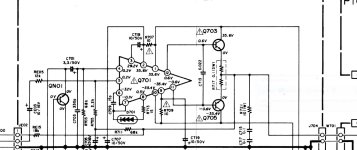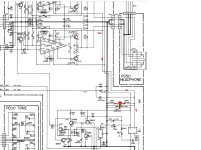Hello,
I haven been using an old Marantz SR340 as my main amplifier for my music, driven by a laptop through the Aux input.
It worked great for years.
Then at some stage, Upon power on, I suddenly heard a loud abnormal pop and humming noise from the right speaker.
I repeat the power cycle and it was gone.
One day I turned it on for longer with the noise present to do some troubleshooting.
I suddenly smelled something and immediately turned the amp off. I know that smell very well.
The the smell came from the right speaker and then I knew immediately that the problem with the amp is DC into the speaker.
The amp was fine again after this but I stopped using it. The speaker is still ok as well b u I know it burned the enamel on the coil wire.
So what can be causing occasional DC onto the speaker in such an amplifier? Only sometimes.
It has a 2 driver transistors in the output stage and they are directly driven from IC Q701 = uPC1225H The transistors are Q703=2SD896 and Q705=2SB776
I have attached a small section of the circuit as I do not want to get in trouble for copyright etc.
I haven been using an old Marantz SR340 as my main amplifier for my music, driven by a laptop through the Aux input.
It worked great for years.
Then at some stage, Upon power on, I suddenly heard a loud abnormal pop and humming noise from the right speaker.
I repeat the power cycle and it was gone.
One day I turned it on for longer with the noise present to do some troubleshooting.
I suddenly smelled something and immediately turned the amp off. I know that smell very well.
The the smell came from the right speaker and then I knew immediately that the problem with the amp is DC into the speaker.
The amp was fine again after this but I stopped using it. The speaker is still ok as well b u I know it burned the enamel on the coil wire.
So what can be causing occasional DC onto the speaker in such an amplifier? Only sometimes.
It has a 2 driver transistors in the output stage and they are directly driven from IC Q701 = uPC1225H The transistors are Q703=2SD896 and Q705=2SB776
I have attached a small section of the circuit as I do not want to get in trouble for copyright etc.
Attachments
No, the amplifier still works fine.
I am clueless as to the cause and originally I suspected a capacitor but there aren't any in the output stage that I can suspect.
I have no experience on that IC and what failure modes it can have. Perhaps it is to blame for this behaviour.
I do not know.
I have retired it for the moment as I do not trust it and want to keep my speaker.
I am clueless as to the cause and originally I suspected a capacitor but there aren't any in the output stage that I can suspect.
I have no experience on that IC and what failure modes it can have. Perhaps it is to blame for this behaviour.
I do not know.
I have retired it for the moment as I do not trust it and want to keep my speaker.
No, the amplifier still works fine.
Hmmm, how can that amp be fine if it burnt/damaged the woofer coil..? That coil is now shorted/shorting and will present a very low (difficult) load to what is already a faulty amplifier.
As advised already above, look for signs of hotspots/cold (dry) joints. As the amplifier heats, these tricky spots (cracks) expand and cause further loss of conductivity, which most likely results in a DC at the output. Post the PCB underside photos here and we'll have a look. In-focus, sharp and well-lit photos will help.
You are in Oz.. the legit source for that driver IC is here...
https://www.wagneronline.com.au/upc...ectronic-components/upc1225h-26459/959541/pd/
I had a few cases where that driver IC developed secondary breakdown spots on its silicon, causing exactly what you are experiencing. The IC has a provision to mount a little heatsink - even a small piece of a copper plate will help a lot because that IC runs very hot at all times.
Last edited:
That is why I am rather stumped. The speaker coil definitely overheated and still smells but the speaker is fine, I tested the impedance and it is in use every day for the past 2 months on a Technics amplifier for now. No issues. I have a pretty sensitive nose and once I smelled it, power was off super fast.
This problems was/is a definite mode it goes into at power up only. Never after that and it was instantly cured by power cycling.
Yea, the ICs seem to be available even on ebay but Wagner is good too.
I guess I could replace it and also re-solder the PCB at the same time.
But will I ever trust the amp again? Hmm...
I may need to get a DC protection device for the speakers from somewhere.
This problems was/is a definite mode it goes into at power up only. Never after that and it was instantly cured by power cycling.
Yea, the ICs seem to be available even on ebay but Wagner is good too.
I guess I could replace it and also re-solder the PCB at the same time.
But will I ever trust the amp again? Hmm...
I may need to get a DC protection device for the speakers from somewhere.
Yea, the ICs seem to be available even on ebay but Wagner is good too.
Seriously ... pay the (more!) money and buy from Wagner - then you know it'll be the 'real thing'. VS. - sadly - likely a fake if you buy from a Fleabay supplier. 🙁
That would be my first thing to look at. See if you can see a definite dry on the chip of the driver transistors. Look for a ring of cracked solder around the pins.Original issue was more than likely a dry joint on the output IC or thereabouts.
These are typical examples.
Hello and update.
Today I had time and had a look at the amplifier PCB.
I found a cracked dry solder joint between 2 large resistors.
I have marked this on the schematic in red.
Could that cause DC going to the speaker(s) ?
The resistors seem to link the power supply rectifier negative to the amp ground basically through 540 Ohm.
There were no other obvious dry joints but I resoldered most of the PCB anyway and then cleaned it.
Cleaning also removed the conformal coating it has before. I am not sure why that was so easy to dissolve.
What do you think?
Is it safe to use the amp again?
Pictures are from before any re-soldering
Best regards
Bernt
Today I had time and had a look at the amplifier PCB.
I found a cracked dry solder joint between 2 large resistors.
I have marked this on the schematic in red.
Could that cause DC going to the speaker(s) ?
The resistors seem to link the power supply rectifier negative to the amp ground basically through 540 Ohm.
There were no other obvious dry joints but I resoldered most of the PCB anyway and then cleaned it.
Cleaning also removed the conformal coating it has before. I am not sure why that was so easy to dissolve.
What do you think?
Is it safe to use the amp again?
Pictures are from before any re-soldering
Best regards
Bernt
Attachments
Hmmm 🙂
Those resistors on the diagram look to be placed across the large 6800uF capacitor and are just to quickly discharge that cap on power off. They look like they run very hot which is why they have suffered. So I'm going to say no, not the cause 🙁 but keep looking 🙂
Its not easy looking at pictures but what is this:

And things like this could be suspect:


Those resistors on the diagram look to be placed across the large 6800uF capacitor and are just to quickly discharge that cap on power off. They look like they run very hot which is why they have suffered. So I'm going to say no, not the cause 🙁 but keep looking 🙂
Its not easy looking at pictures but what is this:
And things like this could be suspect:
Thank you for looking at the pictures. The fist one you asked about is just a component leg. Nothing touching.
IThe 2 resistors themselves do not look like they have ever been very hot but that PCB track does. perhaps it heated because of the dry joints.
Dunno but it is fixed.
I am pretty sure that there are now no more dry joint candidates left on the amplifier PCB.
But I am stull hesitant risking my speaker(s), in case it is a failing components randomly doing this.
Do you know of a lower cost DC protector for speakers? I do not have time to build something, unless it was a ready to go kit
IThe 2 resistors themselves do not look like they have ever been very hot but that PCB track does. perhaps it heated because of the dry joints.
Dunno but it is fixed.
I am pretty sure that there are now no more dry joint candidates left on the amplifier PCB.
But I am stull hesitant risking my speaker(s), in case it is a failing components randomly doing this.
Do you know of a lower cost DC protector for speakers? I do not have time to build something, unless it was a ready to go kit
That sort of board material (it looks like paxolin or resin bonded board) discolours very easily with heat so discolouration alone is not a problem.
It is always difficult to know if an intermittent issue really is fixed unless you can actually catch it in a faulty state and so some measurements.
If... and that is an if... there still was a problem then my first thought would have to be that hybrid type driver chip in the first image you posted in the thread (Q701). Again though check for dries on all the pins.
Try connecting a speaker via a low value fuse (say 315ma or lower) and with the amp on give the board a good tap and prod and make sure nothing untoward happens. You could also connect it via a low wattage low value resistor such as a 47 ohm 0.25 watt. If a high offset appeared the resistor would go up in smoke and not the speaker.But I am stull hesitant risking my speaker(s), in case it is a failing components randomly doing this.
It is always difficult to know if an intermittent issue really is fixed unless you can actually catch it in a faulty state and so some measurements.
If... and that is an if... there still was a problem then my first thought would have to be that hybrid type driver chip in the first image you posted in the thread (Q701). Again though check for dries on all the pins.
But I am still hesitant risking my speaker(s), in case it is a failing components randomly doing this.
Buy a $20 driver from Jaycar and use it to test your amp - before connecting up your real (and valuable!) spkrs. No great loss if it happens to go up in smoke!
I just ordered a DC protector PCB from ebay (China). I see the y have been mentioned elsewhere here in the forum.
Last edited:
- Home
- Amplifiers
- Solid State
- Marantz SR340 receiver/amplifier put DC into speaker. Possible causes?


![20240706_114407[1].jpg](/community/data/attachments/1238/1238372-0d2bb3866ecd0087e0a73427f83fb9a8.jpg?hash=DSuzhm7NAI)
![20240706_115105[1].jpg](/community/data/attachments/1238/1238373-6f3ebaa5fb6b001d1cf4887d5f4c00f6.jpg?hash=bz66pftrAB)